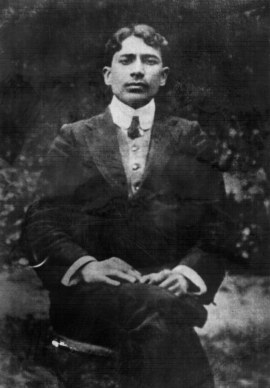A short intro to his family:
Here It’s necessary to draw Madan Lal dhingra’s family’s sketch to highlight the differences between him and his family. They were very different, much like east and west, north and south, day and night. After reading about his family you would easily be able conclude about his personality the circumstances which influenced the formation of his revolutionary outlook.
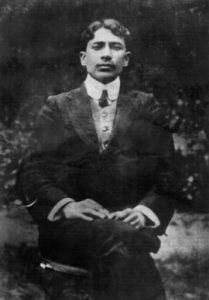
Madan Lal Dhingra ji
Madan Lal dhingra belonged to a very rich and highly respected family of Amritsar. The family shared friendly relations with high British officials and were known for their high status, bureaucracy and well-wisher of imperial rule. Madan Lal dhingra was born to DR Sahib Ditta Mal Dhingra in 18th September in 1883 in Hindu Khatri (Kshatriya) family. Dr Mal had qualified as Sub-Assistant Surgeon from Lahore Medical School in 1867 and as a reputed civil surgeon in Hissar in 1896 when Dunlop Smith was Deputy Commissioner there and they developed a good friendly relations with each other. DR ditta had served as a Medical Officer for British Government for about thirty years. After retirement he was Hon Physician and Surgeon to Mahraja Pratap Singh of Jammu and Kashmir. After retirement he settled down in Amritsar, he owned half a dozens bungalows at GT road and twenty one houses at Katra Sher Singh in Amritsar. He was the first Indian in Amritsar to own a car and he had a six horse driven carriages.
He had seven sons and a daughter:
- The eldest son Dr Kundan Lal ,a widely traveled a flourishing textile businessman.
- Dr Mohan Lal(M.D,F.R.C.S,M.R.C.P from London), well known for his several books on medicine and specially known for book on Physiology ,was Health Officer at Amritsar.
- The next was DR Behari Lal, MD and M.R.C.P from London and was Chief Medical Officer at Jind State.
- Next was Chaman Lal, Barrister at law from London and later the Punjab High Court appointed him as official receiver to the court of insolvency at Amritsar. He married Keshub Chandra Sen’s grand-daughter, niece of Mahrani of Cooch Bihar.
- Next Chunni Lal, another barrister in family was munsif at Jammu.
- After him was Madan Lal Dhingra and the last was Bhajan Lal who was also doing the Bar-at-Law from London at that time.
- The only daughter Kaki Rani was married to Chetan Das of Sahiwal, a big landlord who died at Young age.
Through their father both the brothers Dr Mohan Lal and Dr Behari Lal developed a close relation with Dunlop Smith, during the Gwalior visit of Viceroy Lord Minto. Smith introduced Dr Mohan Lal to the Viceroy and later wrote to him complimenting Punjab Government for having secured the services of a qualified and efficient health office like Dr Mohan for gearing up the sanitary administration in Amritsar. Both these brothers were the joint author of “Minto Health Pamphlet” in 1908 dedicated by the permission of the Viceroy. Dhingra Family being well educated, having high position, engaged in respected professions of medical, law, business, having good relations with British Officials ,enjoyed a distinguished positions not only in Amritsar but in whole Punjab. From these facts you can understand the close proximity of his family with the very highest level of British Officials in India and naturally their pro-regime mindset.The locality of Katra Sher Singh was inhabited by Indians belonging to high class of the society,Dr Ditta owned in this locality a row of spacious house known as “Dhingra Buildings”. The resident of Katra Sher Singh were catholic in outlook and more mindful of the benefits of reciprocal compromises.They preferred to live in English style and dressed mostly like Europeans,using suspenders with trousers and walking with stick just like Englishmen ,though the majority of them wore turban and admired the glory of British rule as a blessing for regeneration of India.On the muzzafarpur bomb outrage of 30 April 1908 ,killing Mrs and Miss Kennedy,the wife and daughter of local barrister ,Chaman Lal dhingra reacted very violently by publishing a letter in Civil and Military Gazette,while expressing his deepest sympathies to the viceroy on tragedy .Madan Lal`s another brother Dr behari Lal expressed similar loyal sentiments to the British Government in 1908 when he submitted a “Scheme of good residential schools for the son of well to do Indians of all creed ,where the students would be made loyal to the British crown “. The two examples cited above show the loyal attachment of Dhingra family towards the British Government. Dr Mal got the title of “RaiSahab” from the English government for his meritorious services and loyalty to crown.From these facts you can understand how his family had relations with the British Officials and their mindset.It was a depiction of his family, which no one would see that a patriot could be born from such a family.But Madan never had such sentiments nor loyalty towards English Government.
His early struggle:
As he was on the path of patriotism, Madan Lal Dhingra had to suffered a lot since his early days. After his Intermediate examination in arts stream with second division grades from municipal college Amritsar, he joined Govt College in Lahore. As a student in the erstwhile capital of British Punjab province, he came into the influence of the freedom struggle lead by . Back in those days, Lahore and Amritsar used to be the epicenter of struggle movement. Famous Freedom Fighters like Lala Lajpat Rai, Ram Bhaj Dutt,Krishna Lal, Lala Duni Chand, Dr Satpal, Lala Hardayal, Sham Lal, Soham singh Pathak(patti), Sukhdev, Teja Singh etc were all Lahore based that time. The electrifying atmosphere of Lahore where slogans of revolution against the British could be heard in each nook and corner of the city, changed his whole life and transformed him into a warrior. He started participating in activities which were deemed to be anti-British and for this reason he got expelled from the college. His family also denied to assist him with this expulsion. He joined Kashmir settlement Dept as a clerk and began working with the great dignity and hard-work. However at the work place, Harsh treatment were meted out to him by the Englishmen which further emboldened his resolve against the British imperialism. He left the job about within six months. After it, he joined as a Tonga driver under Rai Bahadur Daulat Ram at simla-kalka road. After serving there for sometime, he returned back to home as he got the news of his mother`s ill-health. Then he joined as a labor in a factory. But his revolutionary tendencies didn’t leave him there either and he got dismissed from the job for organizing a trade union.
Then he went to Bombay and started working as a Lascar(sailor) in a ship. However the work did not suit him and he left soon after and returned back to home. There, Madan Lal Dhingra’s brother Dr Behari Lal advised him to pursue further studies in engineering. Dr Mal, the father of Madan Lal Dhingra had great admiration for England as his children already received education there. Kundan Lal the eldest son of Dr Mal was a frequent visitor to england for his bussiness purposes. Dr Behari Lal persuaded his father and finally convinced him to send Madan ji to England for higher studies.
His arrival at London and visit to India House:
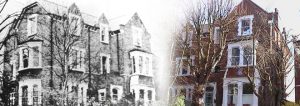
India House ,London
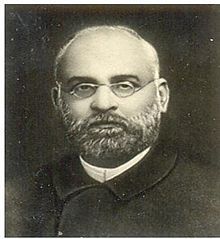
Shyamji Krishnavarma
He arrived in London in July 1906 and joined the university college London to study Mechanical Engineering.Like other Indian students who went to England for higher studies, he visited “India House”. By and large Indian students felt lonely and very much isolated in England and among Englishmen and culture.It was quite natural for the English by force of circumstances and clamor of individual to show in their attitude towards Indian their superiority and dogged arrogance and as a Indian student was apt to suffer from such social barriers and psychological tensions .The English climate and did not suit him and he often complained of the raw ,unpalatable food,particularly beef which he would not ever dare to touch.From his record of activities in England it is clear that Madan ji mixed a great deal with his compatriots and did not shun their company as was common with Indians of aristocratic bearing who preferred to develop social relations with the English only.As he was from a very rich family ,he had enough means to lead an easy life unencumbered with any financial strain,he could live the style of dandy,dancing,drinking and visiting all the quarters freely and because of his family connections ,he could also move in English social circle easily.”For explaining his assassination of William Curzon,we must look rather to England than to India because it was in England where he formed his sacrifice beliefs and planned his action.”During his visit to India House he fell under the spell of Vinayak Damodar Das Savarakr and Shyamji Krishnavarma .Savrakar ji ,the leader of revolutionary movement in England.Madan ji resided there for about six months from March or April 1908 and also for a month in early 1909.The India house was the hub of revolutionary activites in England and specially known for it activities and leaders between 1907-1909.Shyamji Krishnavarma can called as “The Architect of the revolutionary Movement”in England and opened a hostel under the name of “India House” on 1 July 1905 at 65,Cromwell Avenue,High gate,London,as a residential for Indians.Apparently India house was to provide board and lodgings to Indian students at reasonable rates and large number of students went to India House attracted by Hindustani meals and cheaper accommodations.Madan ji felt drawn to Veer Savarkar ji.Both Madan ji and Savarkar ji had arrived in England in 1906.Savrakar ji was of 23 and madan ji was about of 19.Veer Savrakr ji main aim was to inculcate the young men whom he had gathered round with revolutionary ideas and to involve them in revolutionary activities.He believed that it was unthinkable that anything could come about by peaceful argument and the ruling power would surrender .For building up a selfless and fearless framework of revolutionaries ,he evoked admiration for India`s heritage and antipathy for British rule.He choose the the theme of Struggle of 1857 for rousing the national consciousness which he called the First war of independence .Madan ji was very shy and reserved,he seldom spoke at India House meetings but there was hardly a meeting he missed.Savrakar ji knew that Madan ji was of shy temperament and that his talents could be employed better in background.Madan Lal ji was present at the first meeting of the Abhinav Bharat at the residence of Nitisen Das.He was a resident of Indian House in May 1907 for about a month when Savrakr ji ,Bapat ji and G.C varma was also staying there.He resided again in India House for six months from March or April 1908 and for another month in April 1909 until he shifted to 108 Ledbury Road ,Bayswater,where he lived on the ground floor ,paid 15 shilling a week with partial Board,unusually went out between 11 and 12 and returned mostly at 7 P.M and stayed thereafter home.In april 1909 the anti-British campaign had reached its peak in India House and Madan ji who was resided there was asked by father Dr Mal to vacate it and shift elsewhere.Though he shifted to Ledbury Road,his interest towards India House never shattered.Dhingra ji was present at the meeting on 24 January 1909 and on 26 February when one Naidu read a paper on “How a nationalist views the appointment of the Indian law member”.A report shows him leaving India House in company with Savarkar and nine others ,he had aslo brought his brother Bhajan Lal Dhingra to attend the meeting when Savarkar ji and Koregaonkar spoke violently against the Bencher`s decision to impose restrictions on Savrakr ji and Harman singh.At one of the other meeting the subject was”who is India`s bitterest enemy`s?”while some speaker held it was Lord Curzon,some other felt Curzon was really a friend ,who had kicked indians into wakefulness,while other suggested the name of William Curzon Wyllie who was Political Aid de Camp at the Indian Office to the Secretary of State of India,Lord Morely who it was said ,was swayed by William into adopting a policy of unrestrained repression in India. Madan Lal ji unexpectedly intervened to observe that Curzon Wyllie and Morley were two sides of a coin.He said that we need action and not words.India must have martyrs if our cause is to triumph.He formed the resolution of sacrificing his life to the country in December 1908.He used to read over and over again the articles like “Colored Men and English Women”which appeared in London Opinion ,”Babu Black Sheep” in Cassell`s weekly and various other articles,this was fed by the articles against Indians that used to appear in English paper time to time.This was the another reason which make him to understand that Englishmen only understand force.He wanted to kill the largest number of Englishmen indiscriminately.
His Preparations :
H. K Koregaonkar another revolutionary and member of India House told that he had an idea of blowing up a P&O Steamer,sharing this idea with Veer Savarkar ji but he refused to this by saying that he wanted to firstly killed Lord Curzon and if not Curzon then Morley.Once Dhingra ji got an opportunity near the Suvoy Hotel but two photographers were standing very near to Lord Curzon but Curzon miraculously disappeared.Then he formed the idea of blowing up the House of Common (British Parliament)but it was not possible,then he thought the idea of going to House of Common and shooting indiscriminately at the members from the gallery but it was also not possible as the corridor of the House of Common was restricted to visitors.In London itself, the “Shakti Pooja Committee” was formed with the support of Madan Lal Dhingra and other revolutionaries with the aim of teaching the art of defense like Jui Jitsu(Brazilian Self Defense technique),boxing,wrestling,and for teaching shooting.Self Dhingra ji was its president,JD Das was vice president and Koregaokar ji was treasurer.Madan Lal Dhingra and JD Das also wanted to open other shooting organization with their British friends but they did not support them, later the idea was rejected.Later Dhingra and his other friends started practicing at the “Henry Stanton Morley” shooting organization at Tottenham, Court Road, London.Within a few months Madan Lal Dhingra became skilled in shooting.The two events of 1909 determined his future course of action, the first being the “Manifesto of the Polish Revolutionary Party”, which advocated arms and militancy, and described it as a method of achieving independence by a historically subjugated people.The second was the arrest, conviction of Ganesh Damodar Das (brother of Veer Savarkar), and the transportation for life, in Nashik, in which he was sentenced for waging war against the empire.He had already taken a pledge and mingled into the society of high officials and retired bureaucrats, through membership of the Elite Club in London and he also joined the Indian National Association for his express purpose so that some essential people could be connected. He knew that the British imperialists were aware of the revolutionary activities going on in India House and he judged Curzon is dangerous man in anti-revolutionary activities in England and India .Curzon founded a rival youth club to incite hatred of revolutionaries in the minds of Indian youth, and at the same time he started spying on the patriotic students, so that he began to report to the Secretary of State and the government about them.Madan Lal Dhingra ji knew that Curzon was very arrogant and abusive in every way, he had also taken offense to Indian students many times, his past records reflected his feelings of enmity,he used to shame and torture Veer Savarkar and Krishna Verma from time to time and other revolutionaries of India House.Curzon had close ties with Madan Lal Dhingra’s family, he would periodically share the news of a revolutionary movement of Madan Lal Dhingra to his home and his brother Kundan Lal and when his report reached India to madan ji`s family that he was resident of India House and he had a very close relation with Veer Savarkar ji and Krishnavarma and other revolutionaries ,Kundan Lal wrote a letter back to Curzon to look after the Madan ji and bring back him to right path.Because of the obligation which curzon felt he had for dhingra family he wrote to Madan Lal dhingra on 13 April 1909 before two and half months before he was shot,he wrote the following:
Your brother Mr Kundan Lal,whose acquaintance I had the pleasure of making in England,has written to tell me you are in London and asking me to be of any assistance I can to you.I expect to be abroad from the 15 to 30th April,but on my return I shall be very pleased to see you at India House if you can convenietly call between 11 and 1 or 2.30 and 3.30.
I remain
yours faithfully
WHC Wyllie,Lt Col.
but Dhingra ji ignored the letter and he did not meet Wyllie.He knew that wyllie`s aim was to dissuade him from identifying himself with the group of revolutionaries in India House,he reacted violently to it beacuse he thought that it was none of curzon`s business to interfere in his public or private affairs.Wyllie replied to Kundan Lal that he had written and sent his message but he had recieved no reply.Emma Josephine Beck Hon Secretary ,National Indian Asscoiation,whom wyllie had asked for Dhingra ji`s address and also wrote to Dhingra ji on 5 may 1909 requesting him to see curzon.Wyllie probably thought that he had better approach Dhingra ji through Miss Beck who because of her work at National Indian association enjoyed the reputation and helpful person among Indian students .Madan ji did not even answer to this letter and he begun to feel strongly that he was being shadowed by the authoriteis and that some of the offcials ,who happened to be closely associated with his family in India.Wyllie`s letter to his family disturbed the Dhingra Family which was quite natural.In the end Madan Lal Dhingra decided to kill Curzon, in fact since his decision he had been regular enough to practice at the Tottenham Shooting Range in May and June, until the day he did not kill Curzon.There was no fixed time for him to go the range ,he would reach there 12 or 1 P.M or in the evening about 5 pm as it suited him.He had purchased the pistol ,the Colt Automatic Magazine from Messers Gamage Limited on 26 January for ₤3 5s. He produced a gun licence taken out in the name of Madar Lal Dhinghra, of University College and going to range same day.His tutor Henry Stanton had given a vivid account of his shooting practise.According to him Madan ji practised with his own pistol and ammuniton and attended the range for about two to three months.His practice was kept secret from everyone, even his landlady Mary Harris and his brother could not find out.
Assassination of Wyllie:
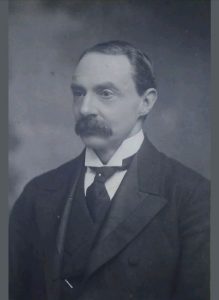
Curzon Wyllie
When he came to know that on the evening of 1 July 1909, the Indian National Association was going to organize a ceremony at the Jahangir house at the Imperial Institute, London, where the Englishmen would gather in large number, including Lord Curzon, Lord Morley, Lord Curzon Wyllie. He decided with great enthusiasm that this will be the last ceremony of the protesters of India today.He spent the day of 1 July in very interesting way ,he did not met Veer Savarkar on 1 July as he was not in London,he had left for reading a day or two before.He had spend most of his time in lodging and did not go much in the evening.He had left his lodging at about 2 P.M or a little before dinner and returned home about at 6 P.M ,thus he remained out for almost 5 hours and this was his practicing hour.According to his coach he was at shooting range on 1 July at about 5.30 P.M .On 28 June he had visited a range at 12 noon and he used to fire 12 shots on each visit. He took a lot of care in his shooting and acquired considerable proficiency. On July 1, about 5.30 p.m., he was at the range, and I saw him fire 12 shots at a target at a distance of 18 ft. (The target was shown to the Jury; there were 11 hits.) and asked Morley (his coach) to clear his pistol which he did by rubbing the pouch through pistol and after that he returned the pistol to dhingra ji and he left from the range.After coming from range he returned to his lodging at 6.30 P.M and again left the lodging at 7 or 8 P.M.He was going to attend the function at Jahangir house at the Imperial Institute.He was dressed in English dark long suit and wore a blue turban.He first went to see some of his associative in a restaurant and Some have alleged that he intoxicated himself with cannabis before setting out to commit the assassination. However nothing could be conclusively established in this regard.He arrived at function at about 9 P.M ,Emma Joseph was also present there and talked to him for about half an hour ,she inquired him about his future plans ,he answered that he intended to take up A.M.I.C.E exams in October after which he proposed returning to India.He was upset for few moments as neither Morely nor Curzon were visible to function as they both were expected to be part of function.Though he kept hoping for them to be there.But after a few moments about half an hour he saw that Curzon was coming with his wife,He had decided to kill Morley but as he was not there ,his eyes fell on Wyllie who had tortured the Indian students community because of his sinister design of shadowing their movements.He moved up and engaged wyllie in his conversation and fired four shots from very close range.One bullet shattered his right eye and another bullet pierced his face below the left eye and he fired another shot when a Parsi Doctor Cowasji Lalcaca come forward to save wyllie,he shot him in self-defense because he had caught Madan ji,he also stated in the court that he had no intention to kill doctor and he shot him in self-defense only.This was the first fire in London by Indian revolutionary which was the clear indication for the Britishers that Indians are awaken now.When he was called as murderer by someone in crowd ,he objected and said he was a patriot and working for the unyoking of his motherland from alien yoke and perfectly justified what he had done.He did not try to escape and got himself arrested.Some eye witnesses said this in their statements:
DOUGLAS WILLIAM THORBURN. journalist. I was present at the entertainment at the Imperial Institute on July 1. About 11 o’clock I was in the main hall. On looking through the doorway of the vestibule I saw prisoner apparently speaking to Sir Curzon Wyllie. Prisoner raised his arm and rapidly fired four shots in Sir Curzon’s face—into his eves. Sir Curzon collapsed at the fourth shot. After a short interval there were two more shots, but I did not see in what direction they were fired. I ran to prisoner to prevent anything further being done, and others also rushed to the spot. Prisoner had his right hand free and he placed the revolver to his own temple, but there was merely a click. With assistance I got him down. I asked him, “What have you done? Why did you do it? ” Prisoner looked at me quietly but did not say anything. He later on said, “Let me put my spectacles on.”
Captain CHARLES ROLLESTON, another guest at the entertainment, spoke to hearing five shots. One shot was fired deliberately by Prisoner at a native Indian gentleman in evening dress. The gentleman—Dr. Lalcaca—fell backwards. The body of Sir Curzon Wyllie was lying three or four yards away. Witness asked prisoner his name and address, and he gave them as “Dhingra, Ledbury Road.” Witless, speaking to him mostly in Hindustani, asked what could be his motive for the crime. He replied, “I will tell the police.
“Dr. THOMAS NEVILLE, 123, Sloane Street. On July 1 went to the Imperial Institute and there saw the dead body of Sir Curzon Wyllie. Later that night I saw prisoner at the police station; he seemed quiet, calm, and collected. I asked him whether he was hurt, and he said “No.” I felt his pulse; it was quite regular and normal. On making a postmortem examination of Sir Curzon Wyllie I found a bullet entrance wound on the right eye, with an exit wound at the hack of the neck; another two wounds on the left eye and at the hack of the neck; two other wounds, one below the left ear, the other over the left eyebrow, the bullets being found in the head. The cause of death was injury to the brain; death must have been instantaneous.
Police-constable FREDERICK NICHOLLS, 476 B said that on being called to the Imperial Institute he found prisoner being held by several gentlemen, and he took him into custody. On his being searched there were found in prisoner’s waistcoat pocket the pistol and the dagger produced.
Police taken him to Walton Street Police Station and during investigation ,they found his right hand inside great pocket a revolver (a six chamber fully loaded) and a dagger in a leather case ,a roll of papers ,a small slips of paper,a pen knife,few keys,some money about six or seven shillings,a pair of spectacles in case,several loose keys,a handkerchief and pair of glasses.They recovered from his lodging a picture postcard of the original painting of the great Russian painter Verastchagin depicting the blowing off Indian rebels from the muzzles of field gun in India,1857-58 and the other a portrait of Lord Curzon on which was penciled “Heathen Dog”and a photograph of Tarak Nath Dass exiled revolutionary and a photograph of British Parliament hanging up side down.The police took him under their custody and send him to Brixton Jail.He was subjected to severe cross examination but he answered the interrogations with smile.He regretted Dr lalcaca`s death and made a statement about it Albert Draper:”The only thing that i want to say that there was no wilful murder in the case of Dr Lalcaca.I did not know him .When he advanced to get hold of me,I simply fired in self-defense.But about wyllie he had no remorse,he wanted to kill him and so he did it,it was just that.
During his custody:
It was a shocking moment for all especially for the members of India House.After Madan ji`s arrest just after it ,a meeting were organized at India House ,the members greatly admired his act but they were now deeply concerned about his beloved associate.According to the report of the Scotland Yard ,they were anxious to offer defense and solicitor to him and they approached .Dr T.S Rajan and later H.K Koregaonkar met him in jail but Dhingra ji take down the suggestion.Veer Savarkar and H.K Koregaonkar ji again jointly met him on 23 July and had a conversation of about quarter of an hour .Savrakar ji during this conversation insisted him to put up a defense but he too failed.V.V.S Aiyer too associated himself with Dr Rajan and Koregaonkar to bring up a defnece for him.G.S Khaparde who lived in London those day noted in his diary that Dr Pollen went to Dhingra ji with an offer to defend him but Madan ji refused.Dhingra ji also received letters from Indian living in England on the same object but he was determined not to accept any defence .He was adamant on his one statement that his actions are morally right and he is justifying it.He was convinced that what he had done was just the right thing to do and that he would do it over again if another such opportunity were ever offered.He said in his statement that “Neither The British Court of Justice,nor British Public opinion nor even the leaders of Indian Opinion who condemn the use of violence for political ends could really judge the my act dispassionately-my real judge in a matter like this which involve higher justice was my own conscience and some of my close associates like veer savrakar ji,Koregaonkar ji,Harman Singh,and others who had organized the brotherhood in arms against the British Crown in India.His Brother Bhajan Lal wanted to engage a solicitor for him but Dhingra ji even refused to see him,who visited the prison for that purpose.Some of his friends who met Dhingra ji prison found him in high spirits .When Charles,the Sub-Divisional Inspector read out the charges of wilful murder against him,Dhingra ji nodded his head and replied”Yes”. He was as usual,very reserved in the court .Ilbert Issac Superintendent of Bench Division,stated that on hearing the charges .Again he simply nodded his head,his lips moved but what he said was inaudible.At one time ,he is reported to have raised his head in the court and said softly ,though firmly “you can pass sentences of death on me.You are all powerful and do what you like.But remember we shall have our time”. On the another occasion ,he saluted in military fashion in the court and addressed the judge,”Thank you ,my lord,I am glad to have the honor of dying for my countrymen”. Four days before he was hanged,he appeared in the court and saluted in same military fashion ,repeating almost the same decleration “I thank you my lord,I am prepared to lay down my life.It is a great honor.
His Answers to the Charges:
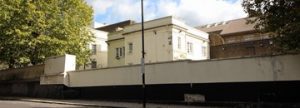
Pentonvillie Prison
On 10 July answer to his charge,he read out the following statements:
” I do not want to say anything in defense of myself I do not think that any English law Court has any authority to convict me or detain me in prison or to pass sentence of death to me.That is the reason I did not have any counsel to defend me and I maintain that if it is patriotic in an Englishman to fight against Germans if they were to occupy his country ,it is much more justifiable and patriotic in my case to fight against the English ;I hold the English people responsible for the murder of eighty millions of my countrymen ,Indians in last fifty years And they are also responsible for taking away 100,000,000 pounds every year from India to their country .I also hold them responsible for the hanging and deportations of my countrymen,who do just the same as the English people here are advising their countrymen to do;and an Englishmen who goes out to India and say, gets 100 pound a month ,that simply means that he passes sentence of death on 1000 of my poor countrymen .Because these 1000 people can easily live with those 100 pounds which the Englishmen spend mostly in his pleasures.Just as Germans have no right to occupy their country ,so that English people have no right to occupy India and it is perfectible justifiable on our part to kill an Englishmen who is polluting our sacred land .I am surprised at the terrible hypocrisy ,force and mockery of the English people,when they pose as the champions of oppressed humanity,as the people of Congo and Russia ,where there is much terrible oppression and terrible atrocity commuted in India ,for example killing two millions of people every year and outraging our women .In case,this country is occupied by Germans walking with the insolence of conquerors in the street of London ,goes or kills one or two of Germans ,then that Englishman is to be held as a patriot of the people of this country ,then certainly I am patriot too,working for the emancipation of my motherland .Whatever else I have to say is in my statement which is in the court”
Dhingra ji concluded :I made this statement not because I wish to plead for mercy or anything of that kind I wish that English people should sentence me to death for in that case,the vengeance of my countrymen will be all the move keen.I put forward this statement to show the justice of my cause to the outside world especially to our sympathizer in America and Germany thats all.Dhingra ji wanted to read aloud his last pronouncement before the magistrate which he was refused .Veer Savrak ji never believed in missing opportunities and was anxious that dhingra ji`s statement should receive the widest possibly publicity because he thought that its publication would not only create a great impression but further the revolutionary cause .He contacted David Garnet who used his influence and the statement appeared in the Daily News on 18 August 1909 and this was Garnet`s account of background: I met Savarkar shortly afterwards and he gave me a copy of Dhingra`s Statement and asked me if I could published it .It appeared in the paper next morning.Dhingra ji`s statement entitled “Challenge” is as follows : I admit,the other day I attempted to shed English blood as an humble revenge for the inhuman hangings and deportations of patriotic Indian youths .In this attempt I have consulted none but my own conscience.I have conspired with none but my own duty.
I believe that a nation held down by a foreign bayonet is in a perpetual state of war ,since open battle is rendered impossible to disarmed force .I attacked by surprise ;since guns were denied to me I drew forth my pistol and fired.As a Hindu I felt That wrong to my Country is an insult to my god.Her cause is the cause of shree ram ,her service is the service of Shree Krishna.Poor in wealth and intellect,a son myself has nothing else to offer to the mother but his own blood and so I have sacrificed the same on her alter.The only prayers of God is may I reborn of the same mother and may I re-die in the same sacred cause till the cause is successful and she stands for free for the good humanity and to the glory of god-“Bande Matram”.Madan Lai was tried in old Bailey court on July 23,1909.The decision of sentence him to death was taken in less than 20 minutes,it was a shortest trial in history of English Judiciary.It was proposed that he should sent to Broadmoor for life and that his execution might produce dangerous repercussions in India and threatn the lives of lonely British civilians there and finally he was hanged on 17 August 1909 at Pentonvillie Prison.Some time little before the time of execution took place a large crowd gathered outside the approach of prison ,there were very few Indian students among those present there.He enjoyed a good slumber on the previous night and had to be woken up on the day of his hanging. He performed his morning chores as usual and even had a hearty breakfast. Meanwhile, several Indian youth had mournfully gathered outside the gates of the prison. They were however denied entry inside. Entry was also denied to the waiting journalists. At the stroke of nine, Madanlal Dhingra began his last journey to the gallows. A Christian preacher named Hudson walked up to him to say the final Christian prayer for him. But Dhingra turned him away saying that he was a Hindu.Madan Lal Dhingra was the first Indian young revolutionary who kissed the trap of hanging, Madan Lal Dhingra became the ideal of many revolutionaries, Kartar Singh Sarabha, Udham Singh, Bhagat Singh, Subhash Chandra Bose, Chandra Shekhar Azad and other revolutionaries considered him as their ideal ,Two or three days after preceding of his execution.S.M Master and Koregaonkar had made an aaplication to the Deputy-Governonr of Pentonville prison for permission to be presnt at the execution but this was refused .Dwarkar Das,Veer Savrakar ji and Aiyer ji requested the Governor to be allowed to take away the body but they denied to handover to them.It is not cleared that Madan ji`s was buried or cremated.Dhingra ji wanted his body to be cremated according to Hindu rites.His family rejected his body and the authorities refused to hand over the dead body to Veer Savarkar, the officials accidentally found his coffin while they were searching for the remains of Udham Singh ji.
The Impact:
- After his act of Bravery number of outrages for patrioitc cause,comiited with policital motives since 1909,are 8 in 1909,2 in 1910,8 in 1911,3 in 1912,5 in 1913 ,4 in 1914,22 in 1915,9 in 1916 and 7 upto june 1917.
- The Irish press hailed Madan Lai Dhingra as a hero. So did the Egyptian paper published from Cario, La Patrrie Egyptiemme.
- Mrs. Annie Besant said, “more Madan Lals are the need of the time”.
- Another revolutionary Virendra Nath Chattopadhya started a monthly magazine in his memory, named “ Madan Talwar” from German, and printed by Madam Cama… Soon it became a mouth-piece of all revolutionaries abroad.
- “Bande Matram” 10 Sept. 1909 wrote about Dhingra that he is immortal who with his words and acts will live for centuries.
- Shamaji Krishna Verma, leader of the revolutionaries in England and France also released his statement in The Times London , “Although I have absolutely no connection with the assassination, I frankly admit that I approve of the deed and regard the author as a martyr in the case of Indian Independence. I know the declaration will shock many, but luckily there are even in England high minded publicists who agree with me, the political assassination is not murder.
- Victor Grayson who remained socialist M.P. in 1907-10, in his speech said that I had seen a portrait of the murderer of Wyllie, whom they called an assassin, but I asked to them why not put Lord Morley in and say another assassin. He did not condone the act, but extended his sympathy to the poor Indians, mad and exasperated by the horrors endured by his people.
- Mr. V.S. Blunt, another M.P. of England Stated, “No Christian martyr even faced his judges with greater dignity then Dhingra”. He wrote, if India could produce five hundred men as absolutely without fear as Dhingra, She could achieve freedom, and he also wrote that even Liod George king of England expressed to Winston Churchill, Prime Minister of England his highest admiration of Dhingra’s attitude as patriot. Churchill shared the same views and they compared Dhingra with Plutarch’s immortal heroes.
- Lala Hardayal, founder of the Ghadar Party said, Dhingra reminded me of the medieval Rajputs and the Sikhs who loved death like a bride whose bride-groom comes to take her away. England thinks. She killed Dhingra but in reality he lives forever and has indeed given the death blow to the English Sovereignty in India.
- An American State lawyer’s opinion is fully relevant about Dhingra’s act. He said, “Five years ago nobody dared to speak or write anything oppressive against the British Raj, but the time is changed, people
are boldly declaring their right to over-throw the foreign Yoke by any means what so ever, some use the bomb, some use the revolver, some attempt to blow up trains and “so on” Indians who are friendly with the British Govt, or its agents are denounced as the most wretched and contemptible of traitors. So in the end, it is concluded that the morning of the 17th August 1909 will remain engraved in red letters in the heart of every Indian who loved his mother land. This is the morning that our great patriot, our beloved Dhingra, is swinging to and fro with his sacred neck in the grip of execution ropes in Pentonville prison. This great patriot is no more with us in his earthy body, but in spirit he is with us, will remain with us, will guide us in the battle of the freedom of the mother land, and his name written in the history of India, will go down to posterity.
Family continues to boycott Martyr:
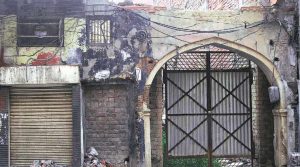
His Ancestral Home at Amritsar
Family continues to boycott Madan Lal Dhingra, even as country celebrates his martyrdom.“It seems the family members are still respecting the decision of Gitta Mal However, his descendants refused to accept his legacy and refused to attend events organized to honor his martyr in August 2015 .The family also sold Dhingra’s ancestral house despite protests from some social and political organizations.BJP leader Lakshmi Kant Chawla offered the family to convert it into museum but the family sold it to a private party,
All information entered is personal to the author. Any modification or changes must be addressed to the author.

